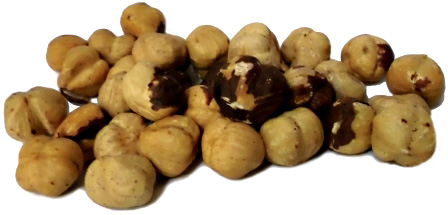...Best of Sicily presents... Best of Sicily Magazine. ... Dedicated to Sicilian art, culture, history, people, places and all things Sicilian. |
by Roberta Gangi | |||
Magazine Index Best of Sicily Arts & Culture Fashion Food & Wine History & Society About Us Travel Faqs Contact Map of Sicily
|
It is believed that the natural (indigenous) range of the hazelnut, genus Corylus, spans a broad area from north-western Europe across the northern Mediterranean and Balkans into Turkey, Persia and northern India. Today, Turkey produces over seventy percent of the world's hazelnuts. In Sicily the hardy hazelnut is cultivated in the Madonie and Nebrodi mountains and around Etna, where the principal cultivars are of the Tonda varieties. It is harvested in late October, after the first chestnuts and olives, often by hand. The Romans loved hazelnuts. Oddly, they are not a very important ingredient in Sicilian cuisine, nor are chestnuts. Not today, anyway. The predominance of almonds, which flourish in Sicily but don't grow in cooler climates, may explain this. In some places hazelnuts, like chestnuts and acorns, are fed to livestock. That is not the case in Sicily, at least not since the Middle Ages. Compared to the almond, pine nut and walnut, hazelnuts are not generally considered a "noble" nut. Also known as the cobnut, the hazelnut is the edible kernel of the cob of the hazel. This tasty seed has a thin, dark brown skin, which is edible. Hazelnuts are high in healthy fats, protein, carbohydrates, various vitamins, folate, minerals (calcium, iron, magnesium, manganese, phosphorus, zinc and potassium) and dietary fiber. About the Author: Roberta Gangi has written numerous articles and one book dealing with Italian cultural and culinary history, and a number of food and wine articles for Best of Sicily Magazine. | ||
Top of Page |
 The humble hazelnut has grown
across Europe since time immemorial – at least since the Mesolithic period
with one site dated to 7,000 BC (BCE) – making its way into northern regions
like Ireland at the end of the last Ice Age and making its name as one of
the oldest European foods. Hardy and nutritious, it seems ubiquitous. Here
in Italy it is an ice cream flavor, nocciola, and a liqueur, nocello
(Frangelico® is a popular brand), and the base ingredient of hazelnut
butter sold as Nutella®. (Noce, as opposed to nocciola, is the
walnut, also cultivated in Sicily.)
The humble hazelnut has grown
across Europe since time immemorial – at least since the Mesolithic period
with one site dated to 7,000 BC (BCE) – making its way into northern regions
like Ireland at the end of the last Ice Age and making its name as one of
the oldest European foods. Hardy and nutritious, it seems ubiquitous. Here
in Italy it is an ice cream flavor, nocciola, and a liqueur, nocello
(Frangelico® is a popular brand), and the base ingredient of hazelnut
butter sold as Nutella®. (Noce, as opposed to nocciola, is the
walnut, also cultivated in Sicily.)